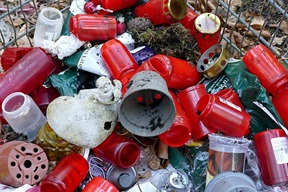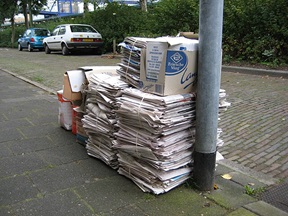Plastic consumption is still rising. Versatile compounds! But plastic recycling isn’t well organized. Therefore, the mountain of plastic waste is still growing. The world needs to find a solution to that problem, A subject addressed at Wageningen University. Their goal: no more plastic waste in year 2050.

Towards zero plastic waste
Global plastics production is still growing, even exponentially; as highlighted by an article on the site of Wageningen University and Research (WUR). But our goal is to arrive at a circular economy. Meaning: recycling all plastic waste. New plastic will then be produced from biobased resources. How do we get there? Researchers from Wageningen delved into that subject.
An appreciable part of plastics that aren’t reprocessed, end up as litter. The amount of litter is still growing. As does the amount of plastics produced. If policy doesn’t change, we will produce twice as many plastics in 2050 than we do now. Growth will primarily take place in Asia and Africa.
Europe’s role
In its combat against plastic waste, Europe plays an important part. The European Commission issued guidelines intended to curb the use of plastics. The most ambitious one is the Packaging and Packaging Waste Regulation (PPWR). This requires high recycling percentages, high amounts of recyclate in new products and reuse of plastic articles. Moreover, this guideline puts a maximum to the number of plastic bags that a European consumer is allowed to use daily. Some countries, like the Netherlands, have even formulated stricter goals: a fully circular economy. Meaning that almost all paper, plastics and textiles should in due course be processed for reuse. And that the resource should be biobased.

Formulating policies is easy, executing policies is much harder. Plastics, according to WUR, are cheap. Most recycled plastics are more expensive than virgin plastics. And plastics are light, important in transport. Plastics also protect effectively against dirt and decay. And they are lighter than competing materials like glass. All these factors mean that plastics have become part of our food safety. And plastics often come in very handy, particularly in once-through use.
Plastics, very handy
Plastics have changed our habits fundamentally. We now throw away much more nondegradable materials than we did before. How do we change this? How can we change consumers’ habits in such a way that they too, will use plastic objects for a long time, or in multiple uses? That is the fundamental question of plastic waste.
Researchers at Wageningen University wondered is policies start at the right side of the problem. At present, their main goal seems to be to restrict once-through use. For instance, bed-and-breakfast landlords will shortly not be allowed anymore to present small plastic cups for products like butter, jam, peanut butter and condensed milk. Will the alternative be that more product will be wasted? It is easy to restrict the use of once-through plastic packaging in canteens and on festivals, but what will happen where there is no oversight, for instance in parks and in the train? And if we restrict plastic consumption, will we also curb plastic production?
Towards a circular economy
The ultimate goal is to arrive at a fully circular economy: towards a society with zero plastic waste, that only circulates recycled or biobased plastics. But there are many varieties of plastics around, that all require a different approach.
- PET (polyethylene terephthalate) is quite recyclable. But PET is being used in many more applications than just bottles. We need to redesign PET plates for recycling; and build more recycling capacity.
- Polyethylene (PE) can best be processed by incineration. Here, the resource is the limiting factor. It is quite feasible to produce PE from sugar cane for instance, but at the moment this is too expensive. A financial incentive should facilitate this pathway.
- We can substitute polypropylene (PP) with polylactic acid (PLA). But this plastic doesn’t fit into the present recycling system. This will only change if much more PLA would be produced.
Recycling plastics has a major problem: the variety of plastics. Proper recycling is only feasible on the basis of a uniform resource. If plastic waste remains as varied as it is now, then only rough remedies like pyrolysis will be successful. Plastic industry’s favourite solution. But this would effectively keep alive a once-through system. Also meaning: fossil resources for plastics production, as there would not be enough biobased resources for such a system.
A system reset
WUR recycling expert Ulphard Thoden van Velzen is of the opinion that we should therefore ‘completely reset the system’. A redesign of the entire infrastructure; making sure that agriculture will produce the resources for plastics. At present, he says, we are in a phase of searching a direction, a period of chaos. He makes a case for three policy changes:
- An export ban on plastics. The goal being that in the future, Europe will clean up its own ‘consumption’.
- Make sure that plastic products and packaging will become recyclable. Nowadays, plastic packaging consists of many different kinds of plastic. Therefore, cleaning machines often get stuck. Moreover, there are many different glues, inks and softeners in use. The solution: use as few combinations of plastics possible.
- Force the sector towards investing in recycling of biobased packaging. For instance, there is a polystyrene substitute, consisting of paper. But Paper Recycling Holland refuses to accept this. By accepting this kind of alternatives, we might build the biobased economy bit by bit.
Do away with the once-through economy
Ultimately, we need to change the once-through economy; the economy in which we can throw away anything after use – ‘they’ will process plastic waste anyway. The EU develops ‘product passports’. These will contain information on the plastics used in the product, guidelines for recycling the plastic, how often the plastic can be recycled and the possible biodegradability of the product. The goal being to stretch the lifetime of the plastic product. Thereby putting a halt to the throw-away culture. Towards zero plastic waste – in fact, in the long run there is no alternative.
Interesting? Then also read:
Plastic recycling: urgent, but a major problem
The role of chemistry in the reduction of plastic waste
Plastics recycling
